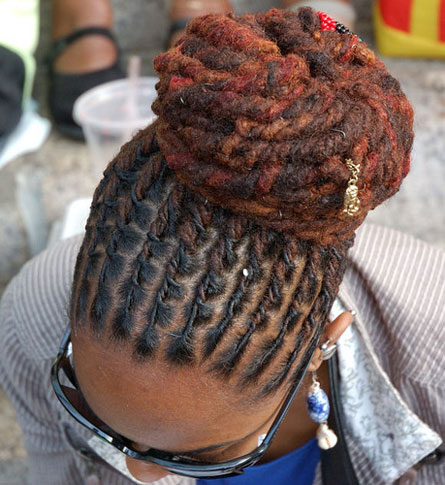Being one of the low maintenance styles, it is a popular way of wearing hair in the natural world. It's also a permanent style, once you are fully locked, reversing the do is a task outside of shaving your head. So, you have to get your mind right before making the decision to lock your hair.
Now that you've made the decision, it's time to choose a starter style. This choice will be based on your personal preference and lifestyle. I have blogged on previous posts the how to's on different natural styles that are great for starter locks. Finger coils, two strand twists, comb twists and single braids are probably the most styles used for starters. In some cases, people even free form their hair, where they just let leave the hair alone and let it lock up without any maintenance.With free form dreads, you are liable to have locks of all shapes and sizes.
 |
| Dreads created with two strand twist |
 |
| Bob Marley with free form dreads |
The process of achieving the the locks that you want is pretty tedious and requires quite a bit of patience. You should expect to go through 5 stages:
Starter
Starter locks is simply the style you choose to begin with. Be sure the sections created are not too small. As the locks grow, if they are too small it is possible for them to break off.
Budding
In this stage, you will notice that your roots are getting puffy and your starter style is getting frizzy. This will be the time to practice re-twisting your new growth. Invest in a good locking gel or even aloe vera gel. Beeswax is also a popular product for maintaining dreads, but it goes back to that whole no no to petroleum thing. As I've said before, read your labels to make sure the product is good for the hair. Also, make sure to keep track of the original section partings when re-twisting to maintain a consistent and uniform size. The length of time for this stage can range from 6 months to a year. Shampooing your hair will be null and void until you get a really good lock going on. Cleansing the scalp with an astringent will be your only hair maintenance at this time.
Teen
Just like a normal teenager, this may be the stage when you are wondering what is going on with your hair. If your hair is short, your teen locks may seem to sprout all over your head and go in any old direction. This is when patience comes into play. If you can persevere through this stage, then you will enjoy the outcome.
Mature
This stage is about 18 months into your locking journey. Your hair should be long enough to lie flat or hang down. You probably won't have to re-twist your new growth as often. By this time you should be enjoying your locks and have a regular shampooing and conditioning routine.
Rooted
This stage is where you have strived to be. Your locks are firmly in place. You can trim your locks to a manageable length if needed. Your hair care routine can be as simple or as complex as you choose, but rooted locks require little more than regular cleansing, conditioning and moisturizing.
 |
| Complex style |
 |
| Simple style |
In general, the thicker and more tightly coiled the hair's natural texture, the quicker your hair will lock. While people with straight or wavy hair can achieve locks, they may need some product help and more time and patience, as the locking process is longer.
Here is a book that may be of interest to anyone contemplating dread locks.
http://www.amazon.com/Nice-Dreads-Inspiration-Colored-Considered/dp/140005169X


Awww....you're teasing my love for dreads!
ReplyDelete